Electronics and Communication Engineering (ECE) Exam > Electronics and Communication Engineering (ECE) Questions > Consider the CMOS circuit shown in the figur...
Start Learning for Free
Consider the CMOS circuit shown in the figure (substrates are connected to their respective sources). The gate width (W) to gate length (L) ratios (W/L) of the transistors are as shown. Both the transistors have the same gate oxide capacitance per unit area. For the p MOSFET, the threshold voltage is –1 V and the mobility of holes is  . For the n MOSFET, the threshold voltage is 1 V the mobility of electrons is
. For the n MOSFET, the threshold voltage is 1 V the mobility of electrons is  .The steady state output voltage V0 is
.The steady state output voltage V0 is
 . For the n MOSFET, the threshold voltage is 1 V the mobility of electrons is
. For the n MOSFET, the threshold voltage is 1 V the mobility of electrons is  .The steady state output voltage V0 is
.The steady state output voltage V0 is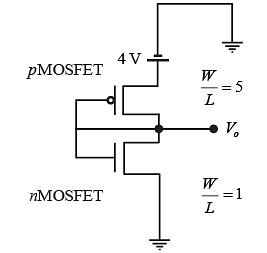
- a)Equal to 0 V
- b)Equal to 2 V
- c)More than 2 V
- d)Less than 2 V
Correct answer is option 'D'. Can you explain this answer?
| FREE This question is part of | Download PDF Attempt this Test |
Most Upvoted Answer
Consider the CMOS circuit shown in the figure (substrates are connect...
Given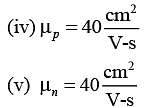


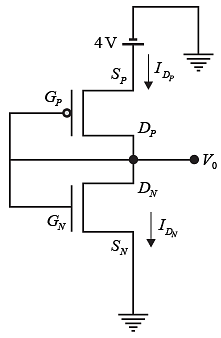

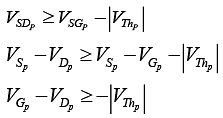












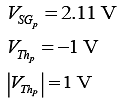




(i) Both transistors have same gate oxide capacitance
(ii) VThp = -1 V
(iii) VThN = 1 V


For n MOSFET :
Condition for saturation is given by,


If this inequality is satisfied then n MOSFET will be operate in saturation region.
From given circuit, 


Therefore n MOSFET is operated in saturation region.
For p MOSFET :
Condition for saturation is given by

If this inequality is satisfied then p MOSFET will be operate in saturation region.
From given circuit, 


Therefore p MOSFET is operated in saturation region.
We can say that, whenever gate and drain terminal of n MOSFET and p MOSFET connected together, both MOSFET will be operated in saturation region.
Since, current flow through gate terminal of MOSFETs is zero, hence both MOSFET will have same drain current.

300(V0 - 1)2 = 40 x 5(4 - V0 - 1)2
3(V0 - 1)2 = 2(3 - V0)2
3V20 + 3 - 6V0 = 18 + 2V20 - 12V0
V20 + 6V0 - 15 = 0

V0 = 1.89V,- 7.89 V
Taking negative value of V0 .
V0 = -7.89 V
For n MOSFET :


Hence, n MOSFET will be OFF and drain current IDN = 0
Since, drain current through n MOSFET is zero so we do not need to check whether p MOSFET is ON or OFF.
Taking positive value of V0 .
V0 = 1.89 V
For n MOSFET :


Hence, n MOSFET will be ON for V0 = 1.89 V
Now we will check n MOSFET is operate either in saturation or linear region


The condition for saturation is given by,


1.89V ≥ 1.89 - 1V
1.89 ≥ 0.89
Therefore, n MOSFET is operates in saturation region for V0 = 1.89 V
For p MOSFET :



Hence, p MOSFET will be ON for V0 = 1.89 V
Now we will check p MOSFET is operate either in saturation or in linear region. V0 = 1.89 V


The conditions for saturation is given by,

2.11V ≥ 2.11V - 1V
2.11 ≥ 1.11
Therefore, p MOSFET is operates in saturation region for V0 = 1.89 V .
Hence, the correct option is (D).
Free Test
FREE
| Start Free Test |
Community Answer
Consider the CMOS circuit shown in the figure (substrates are connect...
Given






















(i) Both transistors have same gate oxide capacitance
(ii) VThp = -1 V
(iii) VThN = 1 V


For n MOSFET :
Condition for saturation is given by,


If this inequality is satisfied then n MOSFET will be operate in saturation region.
From given circuit, 


Therefore n MOSFET is operated in saturation region.
For p MOSFET :
Condition for saturation is given by

If this inequality is satisfied then p MOSFET will be operate in saturation region.
From given circuit, 


Therefore p MOSFET is operated in saturation region.
We can say that, whenever gate and drain terminal of n MOSFET and p MOSFET connected together, both MOSFET will be operated in saturation region.
Since, current flow through gate terminal of MOSFETs is zero, hence both MOSFET will have same drain current.

300(V0 - 1)2 = 40 x 5(4 - V0 - 1)2
3(V0 - 1)2 = 2(3 - V0)2
3V20 + 3 - 6V0 = 18 + 2V20 - 12V0
V20 + 6V0 - 15 = 0

V0 = 1.89V,- 7.89 V
Taking negative value of V0 .
V0 = -7.89 V
For n MOSFET :


Hence, n MOSFET will be OFF and drain current IDN = 0
Since, drain current through n MOSFET is zero so we do not need to check whether p MOSFET is ON or OFF.
Taking positive value of V0 .
V0 = 1.89 V
For n MOSFET :


Hence, n MOSFET will be ON for V0 = 1.89 V
Now we will check n MOSFET is operate either in saturation or linear region


The condition for saturation is given by,


1.89V ≥ 1.89 - 1V
1.89 ≥ 0.89
Therefore, n MOSFET is operates in saturation region for V0 = 1.89 V
For p MOSFET :



Hence, p MOSFET will be ON for V0 = 1.89 V
Now we will check p MOSFET is operate either in saturation or in linear region. V0 = 1.89 V


The conditions for saturation is given by,

2.11V ≥ 2.11V - 1V
2.11 ≥ 1.11
Therefore, p MOSFET is operates in saturation region for V0 = 1.89 V .
Hence, the correct option is (D).
Attention Electronics and Communication Engineering (ECE) Students!
To make sure you are not studying endlessly, EduRev has designed Electronics and Communication Engineering (ECE) study material, with Structured Courses, Videos, & Test Series. Plus get personalized analysis, doubt solving and improvement plans to achieve a great score in Electronics and Communication Engineering (ECE).

|
Explore Courses for Electronics and Communication Engineering (ECE) exam
|

|
Similar Electronics and Communication Engineering (ECE) Doubts
Consider the CMOS circuit shown in the figure (substrates are connected to their respective sources). The gate width (W) to gate length (L) ratios (W/L) of the transistors are as shown. Both the transistors have the same gate oxide capacitance per unit area. For the p MOSFET, the threshold voltage is –1 V and the mobility of holes is . For the n MOSFET, the threshold voltage is 1 V the mobility of electrons is .The steady state output voltage V0 isa)Equal to 0 Vb)Equal to 2 Vc)More than 2 Vd)Less than 2 VCorrect answer is option 'D'. Can you explain this answer?
Question Description
Consider the CMOS circuit shown in the figure (substrates are connected to their respective sources). The gate width (W) to gate length (L) ratios (W/L) of the transistors are as shown. Both the transistors have the same gate oxide capacitance per unit area. For the p MOSFET, the threshold voltage is –1 V and the mobility of holes is . For the n MOSFET, the threshold voltage is 1 V the mobility of electrons is .The steady state output voltage V0 isa)Equal to 0 Vb)Equal to 2 Vc)More than 2 Vd)Less than 2 VCorrect answer is option 'D'. Can you explain this answer? for Electronics and Communication Engineering (ECE) 2024 is part of Electronics and Communication Engineering (ECE) preparation. The Question and answers have been prepared according to the Electronics and Communication Engineering (ECE) exam syllabus. Information about Consider the CMOS circuit shown in the figure (substrates are connected to their respective sources). The gate width (W) to gate length (L) ratios (W/L) of the transistors are as shown. Both the transistors have the same gate oxide capacitance per unit area. For the p MOSFET, the threshold voltage is –1 V and the mobility of holes is . For the n MOSFET, the threshold voltage is 1 V the mobility of electrons is .The steady state output voltage V0 isa)Equal to 0 Vb)Equal to 2 Vc)More than 2 Vd)Less than 2 VCorrect answer is option 'D'. Can you explain this answer? covers all topics & solutions for Electronics and Communication Engineering (ECE) 2024 Exam. Find important definitions, questions, meanings, examples, exercises and tests below for Consider the CMOS circuit shown in the figure (substrates are connected to their respective sources). The gate width (W) to gate length (L) ratios (W/L) of the transistors are as shown. Both the transistors have the same gate oxide capacitance per unit area. For the p MOSFET, the threshold voltage is –1 V and the mobility of holes is . For the n MOSFET, the threshold voltage is 1 V the mobility of electrons is .The steady state output voltage V0 isa)Equal to 0 Vb)Equal to 2 Vc)More than 2 Vd)Less than 2 VCorrect answer is option 'D'. Can you explain this answer?.
Consider the CMOS circuit shown in the figure (substrates are connected to their respective sources). The gate width (W) to gate length (L) ratios (W/L) of the transistors are as shown. Both the transistors have the same gate oxide capacitance per unit area. For the p MOSFET, the threshold voltage is –1 V and the mobility of holes is . For the n MOSFET, the threshold voltage is 1 V the mobility of electrons is .The steady state output voltage V0 isa)Equal to 0 Vb)Equal to 2 Vc)More than 2 Vd)Less than 2 VCorrect answer is option 'D'. Can you explain this answer? for Electronics and Communication Engineering (ECE) 2024 is part of Electronics and Communication Engineering (ECE) preparation. The Question and answers have been prepared according to the Electronics and Communication Engineering (ECE) exam syllabus. Information about Consider the CMOS circuit shown in the figure (substrates are connected to their respective sources). The gate width (W) to gate length (L) ratios (W/L) of the transistors are as shown. Both the transistors have the same gate oxide capacitance per unit area. For the p MOSFET, the threshold voltage is –1 V and the mobility of holes is . For the n MOSFET, the threshold voltage is 1 V the mobility of electrons is .The steady state output voltage V0 isa)Equal to 0 Vb)Equal to 2 Vc)More than 2 Vd)Less than 2 VCorrect answer is option 'D'. Can you explain this answer? covers all topics & solutions for Electronics and Communication Engineering (ECE) 2024 Exam. Find important definitions, questions, meanings, examples, exercises and tests below for Consider the CMOS circuit shown in the figure (substrates are connected to their respective sources). The gate width (W) to gate length (L) ratios (W/L) of the transistors are as shown. Both the transistors have the same gate oxide capacitance per unit area. For the p MOSFET, the threshold voltage is –1 V and the mobility of holes is . For the n MOSFET, the threshold voltage is 1 V the mobility of electrons is .The steady state output voltage V0 isa)Equal to 0 Vb)Equal to 2 Vc)More than 2 Vd)Less than 2 VCorrect answer is option 'D'. Can you explain this answer?.
Solutions for Consider the CMOS circuit shown in the figure (substrates are connected to their respective sources). The gate width (W) to gate length (L) ratios (W/L) of the transistors are as shown. Both the transistors have the same gate oxide capacitance per unit area. For the p MOSFET, the threshold voltage is –1 V and the mobility of holes is . For the n MOSFET, the threshold voltage is 1 V the mobility of electrons is .The steady state output voltage V0 isa)Equal to 0 Vb)Equal to 2 Vc)More than 2 Vd)Less than 2 VCorrect answer is option 'D'. Can you explain this answer? in English & in Hindi are available as part of our courses for Electronics and Communication Engineering (ECE).
Download more important topics, notes, lectures and mock test series for Electronics and Communication Engineering (ECE) Exam by signing up for free.
Here you can find the meaning of Consider the CMOS circuit shown in the figure (substrates are connected to their respective sources). The gate width (W) to gate length (L) ratios (W/L) of the transistors are as shown. Both the transistors have the same gate oxide capacitance per unit area. For the p MOSFET, the threshold voltage is –1 V and the mobility of holes is . For the n MOSFET, the threshold voltage is 1 V the mobility of electrons is .The steady state output voltage V0 isa)Equal to 0 Vb)Equal to 2 Vc)More than 2 Vd)Less than 2 VCorrect answer is option 'D'. Can you explain this answer? defined & explained in the simplest way possible. Besides giving the explanation of
Consider the CMOS circuit shown in the figure (substrates are connected to their respective sources). The gate width (W) to gate length (L) ratios (W/L) of the transistors are as shown. Both the transistors have the same gate oxide capacitance per unit area. For the p MOSFET, the threshold voltage is –1 V and the mobility of holes is . For the n MOSFET, the threshold voltage is 1 V the mobility of electrons is .The steady state output voltage V0 isa)Equal to 0 Vb)Equal to 2 Vc)More than 2 Vd)Less than 2 VCorrect answer is option 'D'. Can you explain this answer?, a detailed solution for Consider the CMOS circuit shown in the figure (substrates are connected to their respective sources). The gate width (W) to gate length (L) ratios (W/L) of the transistors are as shown. Both the transistors have the same gate oxide capacitance per unit area. For the p MOSFET, the threshold voltage is –1 V and the mobility of holes is . For the n MOSFET, the threshold voltage is 1 V the mobility of electrons is .The steady state output voltage V0 isa)Equal to 0 Vb)Equal to 2 Vc)More than 2 Vd)Less than 2 VCorrect answer is option 'D'. Can you explain this answer? has been provided alongside types of Consider the CMOS circuit shown in the figure (substrates are connected to their respective sources). The gate width (W) to gate length (L) ratios (W/L) of the transistors are as shown. Both the transistors have the same gate oxide capacitance per unit area. For the p MOSFET, the threshold voltage is –1 V and the mobility of holes is . For the n MOSFET, the threshold voltage is 1 V the mobility of electrons is .The steady state output voltage V0 isa)Equal to 0 Vb)Equal to 2 Vc)More than 2 Vd)Less than 2 VCorrect answer is option 'D'. Can you explain this answer? theory, EduRev gives you an
ample number of questions to practice Consider the CMOS circuit shown in the figure (substrates are connected to their respective sources). The gate width (W) to gate length (L) ratios (W/L) of the transistors are as shown. Both the transistors have the same gate oxide capacitance per unit area. For the p MOSFET, the threshold voltage is –1 V and the mobility of holes is . For the n MOSFET, the threshold voltage is 1 V the mobility of electrons is .The steady state output voltage V0 isa)Equal to 0 Vb)Equal to 2 Vc)More than 2 Vd)Less than 2 VCorrect answer is option 'D'. Can you explain this answer? tests, examples and also practice Electronics and Communication Engineering (ECE) tests.

|
Explore Courses for Electronics and Communication Engineering (ECE) exam
|

|
Suggested Free Tests
Signup for Free!
Signup to see your scores go up within 7 days! Learn & Practice with 1000+ FREE Notes, Videos & Tests.
























